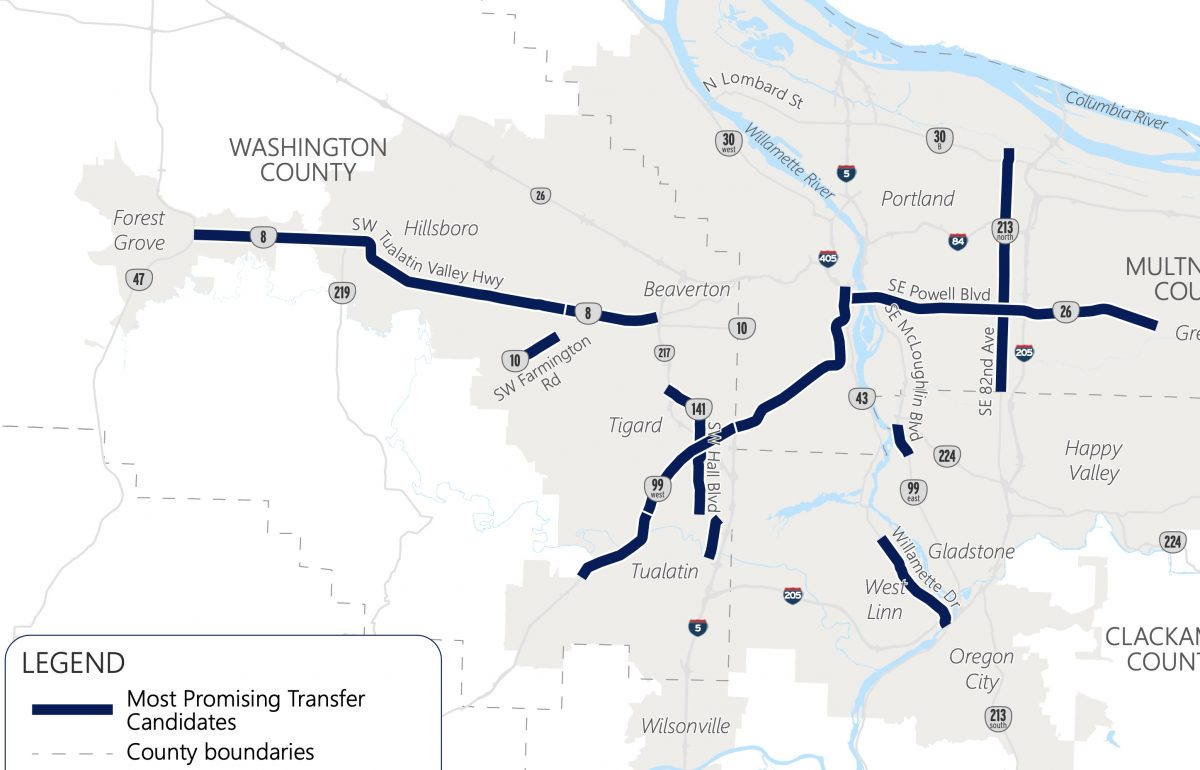
(Photo: Jonathan Maus/BikePortland)
A long-held aspiration of many local transportation planners and advocates has taken a big step forward.
On Tuesday Metro opened a comment period for their draft Regional Framework for Highway Jurisdictional Transfer Study. The study identified a list of 11 state-owned highways that are primed for new management because they’ve been neglected by their current boss — the Oregon Department of Transportation.

(Map: Metro)
These highways — which function more like urban arterials — are relics of a pre-interstate era. They were built to get produce and other items from farms into the central city. When the big, shiny, new freeways were built in the 1950s through 1970s, ODOT walked away from them. They became what are known as “orphan highways” and a cycle of neglect began. As cities and neighborhoods have grown up around them, these highways have fallen out of favor and aren’t prioritized for federal and state funding. In recent decades a wide chasm has formed between the priorities of ODOT, the tragic outcomes of their car-centric street designs, and the daily needs of people who live in communities adjacent to them.
Transferring urban arterials to local jurisdictions would save many lives and allow cities and counties to create healthier streets and neighborhoods.
Below is the list of 11 corridor segments Metro says, “showed the strongest characteristics for potential jurisdictional transfer based on an assessment of technical, readiness and equity considerations”:
1. Powell Boulevard (U.S. 26): MP 0.2 – 10.0
2. Barbur Boulevard (OR 99W): MP 1.2 – 7.6
3. SE/NE 82nd Avenue (OR 213): MP -0.1 – 7.2
4. Tualatin Valley Highway (OR 8): MP 2.9 – 5.9
5. Pacific Highway W (OR 99W): MP 7.6 -11.5
6. Tualatin Valley Highway (OR 8): MP 5.9 – 17.9
7. Pacific Highway W (OR 99W): MP 11.5 – 14.5
8. Farmington Road (OR 10): MP 5.9 – 7.3
9. SW Hall Boulevard (OR 141): MP 2.6 – 7.1 and
MP 7.7 – 8.9
10. SE McLoughlin Boulevard (OR 99E): MP 5.7 – 6.7
11. Willamette Drive (OR 43): MP 8.0 – 11.5
Advertisement
In my years covering this beat I’ve yet to hear anyone who’s against jurisdictional transfer. Even ODOT is eager for it to happen! In 2015 the Governor’s Transportation Vision Panel (which greatly influenced the HB 2017 statewide transportation package) recommended that ODOT form and fund a jurisdictional transfer pilot program. They singled out Powell, 82nd, and Barbur as excellent transfer candidates — all of which are on Metro’s list. State legislators took heed in 2017 and allocated $110 million (starting in 2022) to transfer Southeast Powell Boulevard from ODOT to PBOT.
As the Powell example illustrates, cost is the biggest obstacle to these transfers because local jurisdictions want the road must be brought up to their current standards before making the swap. And there’s all the red tape and technical analysis. That’s where this report comes in. Metro has done a bunch of important leg-work to get these transfers closer to being shovel-ready.
But before you get too excited about what it would mean if, let’s say, the (much more progressive than ODOT) Portland Bureau of Transportation was able to do whatever they please on Barbur or 82nd, keep in mind that this report won’t lead directly to any transfers. If and when they happen, it’ll take just the right mix of political will and funding.
Now is the time to learn about this process and tell Metro what you think about it. The comment period is open until October 22nd.
Here are the links you need:
— Metro jurisdictional transfer report page
— Regional Framework for Highway Jurisdictional Transfer Study (PDF)
— Online survey to share feedback
— Governor’s Transportation Vision Panel jurisdictional transfer overview (PDF)
— Jonathan Maus: (503) 706-8804, @jonathan_maus on Twitter and jonathan@bikeportland.org
— Get our headlines delivered to your inbox.
— Support this independent community media outlet with a one-time contribution or monthly subscription.

